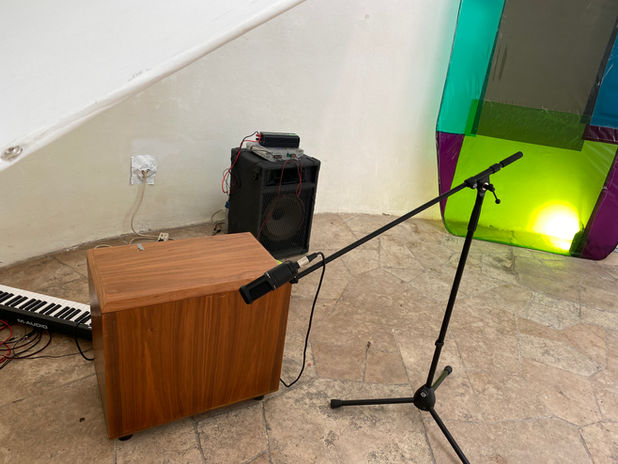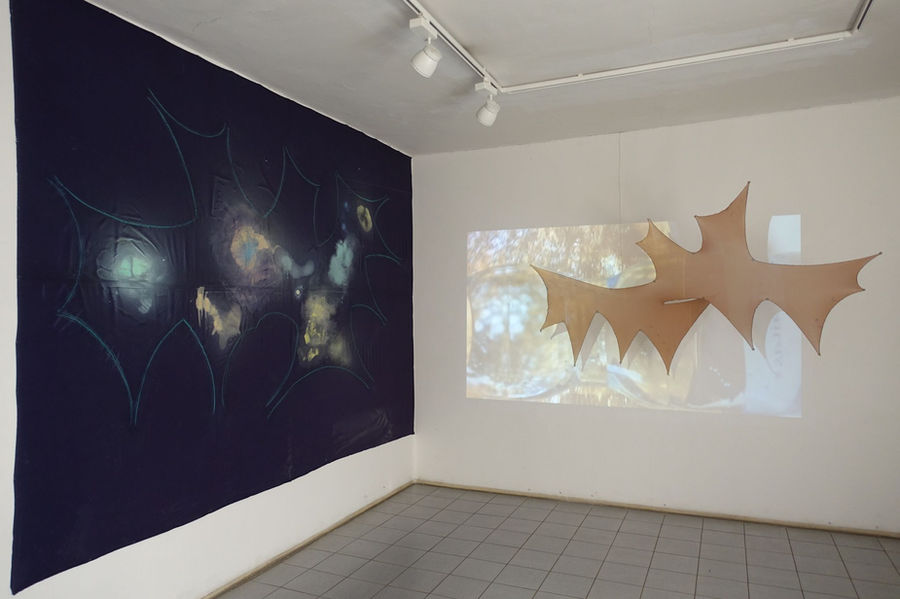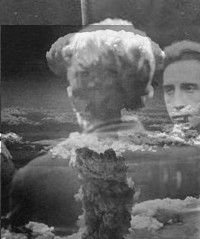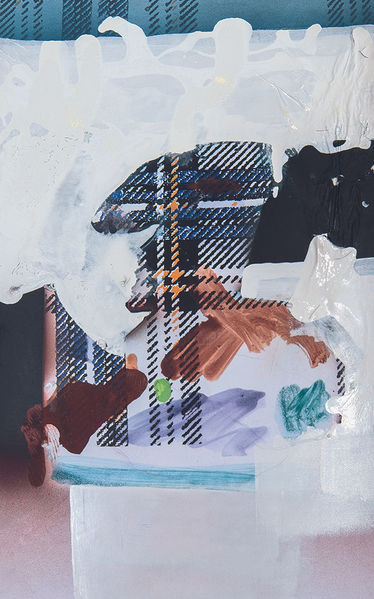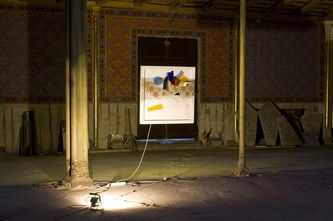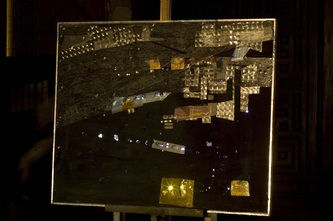KORODI LUCA
Windmill warrior
Below 20Hz (Taming of the Supreme)
Site-specific installation
Location: Kálvária, 2025
Work Description
The sound installation was conceived specifically for the site. The concept I explore has already appeared in my earlier exhibitions. The synthesis of sounds from various religious spaces and urban atmospheres represents the imprint of a compositional process. The source materials were collected during my travels and later mixed together.
Sound Sources:
-
Byzantine early Christian Catholic chant, wedding ceremony atmosphere / Cyprus, Nicosia
-
Muezzin 1 / Morocco: Casablanca, Tetouan, Tangier; Egypt: Alexandria
-
Muezzin 2 – atmospheric field recording / Turkey, Ankara – imam’s chant
-
Radio broadcast / Egypt, on the road along the Nile towards Cairo
-
Catholic church bells / Vienna, rooftop, city atmosphere
The collected sounds were not cleaned or edited — the acoustics of their original environments, the infiltration of city noise, and even the murmur of crowds within sacred spaces all remain present within the sound layers. I was assisted by electronic music composer Fukui Ryu.
A key element of the work is a sound wave stretched below 20 Hz — a frequency no longer audible to the human ear. The amplifier was able to reproduce this subsonic vibration alongside the synthesized audible tones. In the circular, acoustically peculiar space, the result manifests as a powerful, palpable vibration. The experience thus became a visceral, transformative presence for those in the space.
Visual Elements:
Two recurring forms define the visual aspect:
-
An octagonal, elongated, compressed shape made of white elastic fabric, stretched to float in the space. This vertical, membrane-like form also reacts to the sound vibrations, with thin metal wires resonating along with the waves.
-
A hand-bent and welded iron frame, also an elongated octagon with rounded corners, forming a flexible rim. Transparent foil cutouts create a patchwork-like, skin-like surface of colorful rectangles.
Related reference:
https://www.facebook.com/1848499039/videos/pcb.10224128556962186/709117405107981 https://www.facebook.com/events/2691815794540207?acontext={"event_action_history": [{"mechanism":"attachment","surface":"newsfeed"}],"ref_notif_type":null}


slide show
Spring/ Fountain / Boil (Forrás/Forrás/Forrás)
Exhibition, 2022
On the one hand, I work with material collected from various locations throughout the city.
Streets, train stations, airports, markets, open-air places – garden terraces – metro, shopping malls, parks, bridges, harbors, birds, songs, faint traces of street music dissolving into the noise of construction.
Blocks of sound from specific urban sites. It is important that the real sounds and images are here interwoven with electronically generated tones.
The struggle between reality and its reproduction.
The other element is a montage video, made up of images with themes of living flora, microorganisms, and cosmic structures, together with whatever else inspires me.
Constant, swirling thoughts.
The painting process itself becomes part of the source of inspiration. I stumble upon it everywhere — it’s omnipresent.
Sometimes it flows underground, like a hidden spring.
The slideshow that has emerged has grown into a cascade of associations — fluid, yet following a loosely organized and intuitively composed sequence. It is an impulsive, continuously evolving selection.
The final manifestation will take place during the opening, when the sound masses of urban atmospheres are generated and mixed with the visual material, fusing with the particles of the space — merging and imprinting themselves upon us.
Additional elements of the exhibition include natural materials and a painting.
This exhibition is conceptually connected to my previous project “The Skin of the Earth.”
Sources here: https://balkon.art/home/korodi-luca-a-fold-bore-project-2-save as/?fbclid=IwAR1OOOqJB32pYbl6Pet1A28T2DY1a891X4mqVwHb4Wg8E2dJPxbF 6PzqN4M https://balkon.art/home/korodi-luca-a-fold-bore-project-1/ https://www.korodiluca.eu/selected-work?pgid=kj0atomt-1fcc5868-389a-45b8 ad84-0401428b8b98 https://www.korodiluca.eu/selected-work?pgid=kjiswtm1-0b3138f5-5c51-4b65 a74b-28ab59c3166a

SPRING/SOURCE/BOILING
associative slide show



_JPG.jpg)

terra amata
2023

FORRÁS FORRÁS FORRÁS / SOURCE FOUNTAIN BOIL
Létminimum Bázis / Minimum subsistence base / installation /sound performance
Skin of the Earth project 2022
The sound, the urban atmosphere. It blends into the fluid movement of the images and interacts with the atmosphere.
Sound blocks of urban atmospheres are generated and mixed with the visual material. The components of the particles of space merge and are absorbed into us.
Other elements of the exhibition are natural elements (wind, ozone) and a painting.
1. Ozymandias / painting
2. Ozone maker machine - feeling in the air
3. Fountain / video / 5x5 minutes
4. Slide show / video / HDMI 192x1080 5. Fan
Flying monument
THE SKIN OF EARTH

save as ...
Ffrindiau Gallery 2021
No-man's land
In the nimph stage

R.E.M. Phase
I made an exhibition in Drei Raben Gallery in 2018. Pop up situation, when the three object gives another view or layer .
The animation is from 4 element: wind, glass, leaves, blank page (empty canvas)
In the space there was standing a painting which titled: Ozymandias. Half covered large hand from marble in the desert.
The film was shooted in to the flat of the hand, but cross before an object. It called „Rombush rainbow”.
The environmant made a new reality.
(…)as if we were trying to enter, from actual space directly into the world shown in the image. We saw a huge with a swaying venetian blinds, the light beans of the machine, and the roaring voice, behind which, in the dark room, that event was merely drawing on us(…) Tamas Seregi /The birth of an image
Fossils, the remains of marine animals that died a hundred million years ago, were pressed into petroleum in the deeper layers of the earth's crust. The view obtained from these in a vehicle driven by fuel, during a journey above a certain speed, inspired me to document the light phenomena through the speeding windows. I moved the camera in the car window like a gesture, using the camera as a brush. In some cases, their imprints resemble the spine of a dinosaur, shark, or human, the shape of a seahorse, or even DNA. The contrasts and few colors in the exhibition create a cosmic atmosphere. The in-between moments take on the character of calligraphy, the difference is that here I use a camera instead of painting. The almost invisible traces, signs, sounds, and light gestures created in the time between moments take on a calligraphic character, bearing the marks of sign and meaning at the same time.
resonance 2017
Twilight 2015-16, paintings
PANORAMA - electronic light and sound installation
installation/More Light!!!/ Buapest Whale Cultural Centrum

Twilight
2015-16
TWILIGHT PHASES
Twilight phases
I made photo documentation from four different points of the Vienna Flakturm lookout (which was a military observation unit in World War II, a Nazi locator and which could never be demolished).
I have been watching the twilight for a long time, I like to experience the process of entering another world.
The documentation of the phases of twilight is only a starting point for the explanation of the following painting problem:
I like to think in the observation deck, it's an island for me, a metaphor for the different arenas of the ego spied from a distance - or insight.
I don't know what was more important.
Something pushes us forward that makes us constantly change...
Waiting...no man's land
We are inhabitants of the universe, made of stardust. Our home is a rolling, dark, dense material, a cosmic unknown, turning in on itself and pulsating, a barren, emotionless sheet of space.
Or the burning of moments and frames layered on top of each other from the small differences of the transformation observed gradually in the setting sun.
Layers of paint - the perfect reproduction of the twilight blush surface
ratio
below manganese violet, green and orange
white glaze above
cosmic dots in the marble-like velvet cracks of Parisian blues
Imprinting emotional reflections on the canvas of the momentary states of artificial light accents embedded in natural light. Building reflex.
My search for sound, escaping from clichés, is not music, but rather trying to find a clean line of sounds, but one with which I do not want to create my own music, because my goal is not to compose music or a piece of music, and yet another language of my own, but enough of concentrated waves of energy on the empty surface of the canvas to project, to fill it with energy, so that the viewer can then extract it from it.
When I think about the many layers that have been piled on the city and build upon each other the layers of memories of generations. The stalactites of his spirits. Repetitions of faces and buildings, layering of rocks, like ghosts melting and disappearing into each other.
The surfaces of the images are the result of just such experienced processes.
Phases to blackout.
I discover concrete things, states of matter, Transformation! (Kafka). I would like to use the visual.
I want to look at things without seeing them.
I would like to reinterpret what I know, what we know
I close my eyes and open my ears, open my eyes.
The form, silhouette, and details should appear in the image with improvisational coverings, their trace-like presentation.
I cover up the sight to the point of unrecognizability, so that it does not interfere with the transubstantiation. But maybe it's not the sight that transforms in the picture, but I transform into something else in the process. And this obviously leaves a mark on the canvas.
Twilight phases tuning process, techniques. And I figure it out during the creation process.
Vibrating, floating sound - field
louder floating sound - water
clear sound - air
supremacy and breathing
PURE WAR
bulletin board

A World Seen as One Luca Korodi: NGC 7293 in the Rumbach Synagogue By Endre Lehel PaksiIt is always a joy when contemporary art flashes into a sacred space, especially one that is either no longer in use or still functioning as a community venue. But the joy is even greater when this occurs within perhaps Hungary’s most harmoniously proportioned interior, the Rumbach Sebestyén Street Synagogue. No longer measured by scholars, rather, no longer measurable the dome of the sky is tailored to human scale above the earth, offering visitors a place where the body feels at home on Earth. This interior, since I first set foot inside, has stood out as a profoundly distinct experience amidst the increasing contrast of other walkable spaces. Like the church space in Kiscell, it provides a stunning framework—one that demands collaboration rather than opposition. Korodi Luca’s installation, created specifically for this place, gains an entirely unique set of meanings here.It’s not necessary to know that the title of the exhibition refers to an astronomical object catalogued as NGC 7293 popularly known as the “Eye of God” nebula. It is enough to perceive the floor below the building’s dome as our own sphere the Earth, the realm of the human, which here is symbolized by the ground. On this surface, we find the image of Earth. Korodi’s painting has often embraced fragmented forest views and compositions without a central focus. Her landscapes were filled with motif-like elements, but her goal was always to condense life into a single image not to lose herself in details, but to compose a world seen as one from the sum of its parts.Here, that approach becomes quite concrete offered in a simple form that requires no intellectual gymnastics or prior knowledge. On the floor beneath the dome, within a 4-5 meter wide ellipse, a layer of glass shards appears. Beneath these shards, old stage light color filters emerge, modulating the visual tones. White glass indicates water-covered regions; green glass marks landmasses. Below the water, blue filters; under the land, brown. In some places, green and brown-glass fragments blend. A mandala for fakirs: a collection of dangerous, painful fragments that reflect and transmit light. During a daytime walk, the colored light filtering through the synagogue’s stained-glass windows further enriches the visual experience.With this material use, Korodi clearly takes a position contrary to the mindset often described as central to autism: a disjointed, non-integrative perspective. She resists the trend—widely embraced in art and often underpinned by constructivist phenomenology that celebrates a de- and recontextualization of familiar elements without teleological meaning or authorship. While this aesthetic, supported by scientific paradigms, has many prominent practitioners in Hungary (Katarina Sević, Zsolt Tibor, Beatrix Szörényi, etc.), it tends to erase the artist in favor of process or structure.Korodi’s work, in contrast, seems to have discovered a universal minimum that is not tied to individual identity, and can be related to by any fellow human being thus, identity- and culture-independent. In the end, it also rejects the idea that a non-neurotypical worldview could ever offer a hospitable description of reality. Here, the world is indeed seen as one, expressed through a gaze that is never explicitly named, but the installation nonetheless communicates a demand for a mode of thought that transcends the arbitrary chaos of postmodernism. I like to call this new humanism a language suited for cooperation.The short-lived, bodily walkable exhibition had an additional highlight: four of the artist’s works previously shown in New York displayed in a space with wildly decorative wall coverings where African ornamentation and contemporary painting embraced. Only one of the four retained a piece of those visually stimulating textiles. On it, as in the installation and in the other paintings, color filters were applied resulting in a strange, experimental waste-collage. The visual references were powerfully evocative of Merzbau or Constructivism, and the proportions and directions of the composition evoked abstract landscapes. The canvas had punctured holes evoking not only material shortages typical of wartime, but also traces of direct violence. Or perhaps this perforation is already the rusted cauldron of an inverted sky?One of the other paintings deviated least from Korodi’s previous works: a continuation of her urban landscape series. On a trapezoid-shaped canvas, both small- and large-scale city elements appear simultaneously skyscrapers and shantytowns typically unseen together. As if monkeys (recalling earlier ornamental legacies) were moving between these two otherwise inaccessible urban zones here unified painted in a strikingly illusionistic aerial perspective. These ornamental elements function both in foreground and background, reminiscent of the figure of the spirit in our visual tradition. Enhancing this, the painting also contains patches of pigment that respond to ultraviolet light its natural and UV-lit states are equally valid.Korodi’s further light experiments take center stage in the subsequent images urban lights at night return this time from Mexico City. Not her native terrain, thus the works are more distanced in tone not attempting to articulate a local atmosphere or emotional density. These are naturalistic framings and perspectives of night roads and various glowing objects, cleverly rendered not with separate light sources but again with those same color filters. While Malina’s lightboxes presented quasi-sci-fi visions never before seen, Korodi fertilizes the Hellenistic-photographic image tradition with the logic of the lightbox. / Endre Lehel Paksi , art historian,2012, Balkon art magazine





